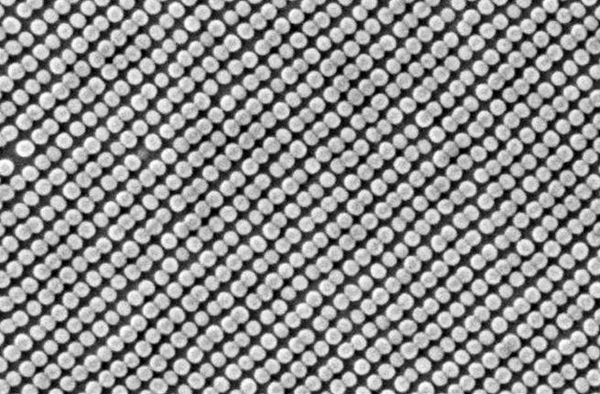HGST, the former Hitachi Global Storage Technologies (now owned by Western Digital), is developing nanolithography processes that will allow the doubling of hard disk drive (HDD) data storage density in future disk drives. HGST Labs is announcing the combination of two innovative nanotechnologies — self-assembling molecules and nanoimprinting — to be able to create large groups of dense patterns of magnetic islands only 10nm wide. Bear in mind that one nanometer equates to one billionth of a meter — about 50 atoms wide. To put this in scale, this would be 100,000 times thinner than a human hair.
Photolithography has long been the preferred technology utilized by the semiconductor industry for creating increasingly smaller circuit features — using ever shorter wavelengths of light, improved optics, masks, photosensitive materials, and clever techniques. These advancements have slowed as ultraviolet sources become increasingly complex and expensive.
Enter “nanolithography”. Tom Albrecht, HGST Fellow, recently spoke at the SPIE Advanced Lithography 2013 Conference in San Jose, CA regarding HGST’s nanolithography discoveries. He describes the patent-pending work his team is achieving in partnership with Austin, TX-based Molecular Imprints, Inc. in making dense patterns of magnetic islands in about 100,00 circular tracks as required for disk drives:
Self-assembling molecules use hybrid polymers, called block copolymers, composed of segments that repel each other. Coated as a thin film on a properly prepared surface, the segments line up into perfect rows. The size of the polymer segments determines the row spacing. After polymer patterns are created, a chip-industry process called “line doubling” makes the tiny features even smaller, creating two separate lines where one existed before. The patterns are then converted into templates for nanoimprinting, a precision stamping process that transfers the nanomenter-scale pattern onto a chip or disk substrate. A key challenge proved to be preparing the original surface so the block copolymers form their patterns in the radial and circular paths necessary for rotating disk storage. HGST is the first to combine self-assembling molecules, line doubling, and nanoimprinting to make rectangular features as small as 10nm in such a circular arrangement. “We made our ultra-small features without using any conventional photolithography” states Albrecht. “With the proper chemistry and surface preparations, we believe this work is extendible to ever-smaller dimensions.”
HGST is becoming a premier force in nanolithography. This announcement represents a creative solution to the problems associated with photolithography, and is a result of the storage industry’s unique technical targets and strict cost objectives. HGST’s nanolithography achievements arrive at a critical point for storage drives — cloud computing, social networking, and the explosion of mobile devices are creating an ever-increasing amount of data and content to be stored, managed, and accessed effectively.
This announcement also provides a roadmap on how to cost-effectively create these magnetic islands at densities that far exceed today’s capabilities. The bit density using HGST’s 10nm pattern is double that of the disk drives of today, and lab tests indicate excellent initial read/writes and data retention. When this is extended to an entire disk, the nanoimprinting process should be able to create more than 1 trillion discrete magnetic islands.
MAGNETIC DISK OF THE FUTURE
The above image shows the dense patterns of magnetic islands made by HGST Labs utilizing the self-assembling molecules, line doubling, and nanoimprinting emerging technologies. Each dot stores one bit of information. This pattern has 1.2 trillion dots per square inch! This is twice the density of current disk drives. According to Currie Munce, vice president, HGST Research, “As creators of the original hard disk drive, we are proud to continue our heritage of innovation with today’s nanotechnology advance. The emerging techniques of self-assembling molecules and nanoimprinting utilized at the HGST Labs will have an enormous impact on nanoscale manufacturing, enabling bit-patterned media to become a cost-effective means of increasing data densities in magnetic hard disk drives before the end of the decade.”
Don’t be so quick to write off HDDs as obsolete technology. The HGST press release can be viewed in its entirety here.
 Technology X Tomorrow's Technology Today!
Technology X Tomorrow's Technology Today!


